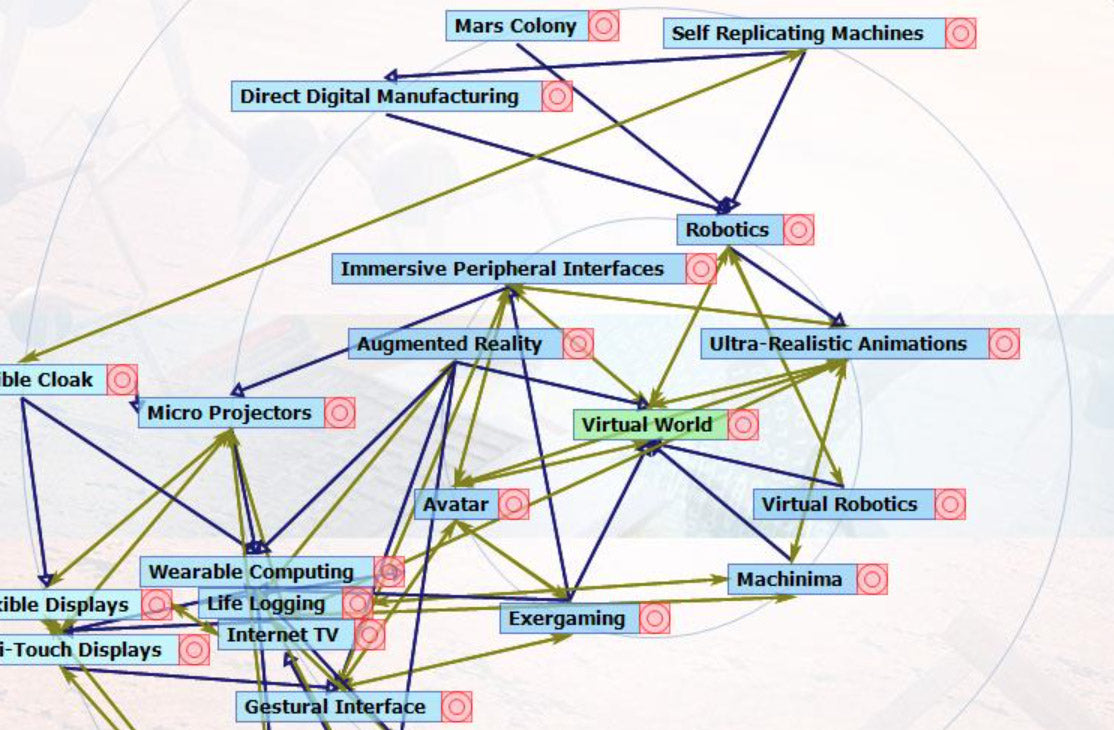Purpose
In this exercise, delegates will learn how to use futures wheel to perform a structured brainstorming to predict the future of a specific topic or systematically capture the effect of various future developments on each other.
The method is a simple yet powerful visual technique that is widely used by people involved in understanding the consequences of change or development.
Objective
Draw a futures wheel for a given topic while brainstorming the topic.
What You Need
- Flipcharts
- Colour pens
Setup
- Explain how futures wheel works:
- Start with the main topic at the centre of the diagram. This is the concept under consideration. Example: Wearable Computing
- Next, identify consequences or events that directly follow from it. These will form the first layer concepts around the central concept. For example: Location-based Services, Virtual Gaming, Augmented Reality, etc.
- Next, for each of these consequences, identify their respective consequences. Some of these may relate to other consequences already identified or back to direct consequences identified in the previous step. Draw a line between the concepts and their consequences to logically connect them. You can use various definitions for this line or even introduce multiple types of relations represented by different kinds of lines.
- Each level is represented by concentric circles.
- As new concepts are identified, you may need to redraw the wheel to make room for new concepts or to place related concepts together to minimise clutter. Software solutions exist that can facilitate this process.
- The final diagram is a highly visual representation of the most important concepts or trends related to the central concept. As you get further away from the central concept, the consequences become less relevant and less important. Example of futures wheels are shown below.
- Make sure delegates have understood the concept before proceeding with the exercise.
- Divide the delegates into pairs. If you have an odd number of people, use a group of 3.
- Distribute flipcharts to each group.
- Ask each group to consider a particular subject, preferably related to their work, and then draw a futures wheel for it. Encourage them to brainstorm the topic in each pair while capturing their ideas. Ask them to use colour pens to increase its impact or redraw the wheel to increase its clarity if needed.
- Allocate 15 minutes for this part.
- Bring back everyone and ask each pair to present their wheel and explain. Encourage others to question the pairs.
- Follow with a discussion.
Timing
Explaining the Test: 5 minutes.
Activity: 15 activity + 15 showcasing = 30 minutes
Group Feedback: 10 minutes.
Discussion
How useful is futures wheel technique? What worked well? What didn’t work well? Are you inspired by other groups’ work? How do you see yourself using this technique in real-world situations?
Soft Skills Training Materials
Get downloadable training materials
Online Train the Trainer Course:
Core Skills
Learn How to Become the Best Trainer in Your Field
All Tags
Training Resources for You

Course Design Strategy
Available as paperback and ebook

Free Training Resources
Download a free comprehensive training package including training guidelines, soft skills training activities, assessment forms and useful training resources that you can use to enhance your courses.

Our Comprehensive Guide to Body Language

Train the Trainer Resources
Get Insights - Read Guides and Books - Attend Courses
Training Materials
Get downloadable training materials on: Management Training, Personal Development, Interpersonal Development, Human Resources, and Sales & Marketing














Leave a comment
All comments are moderated before being published.
This site is protected by hCaptcha and the hCaptcha Privacy Policy and Terms of Service apply.